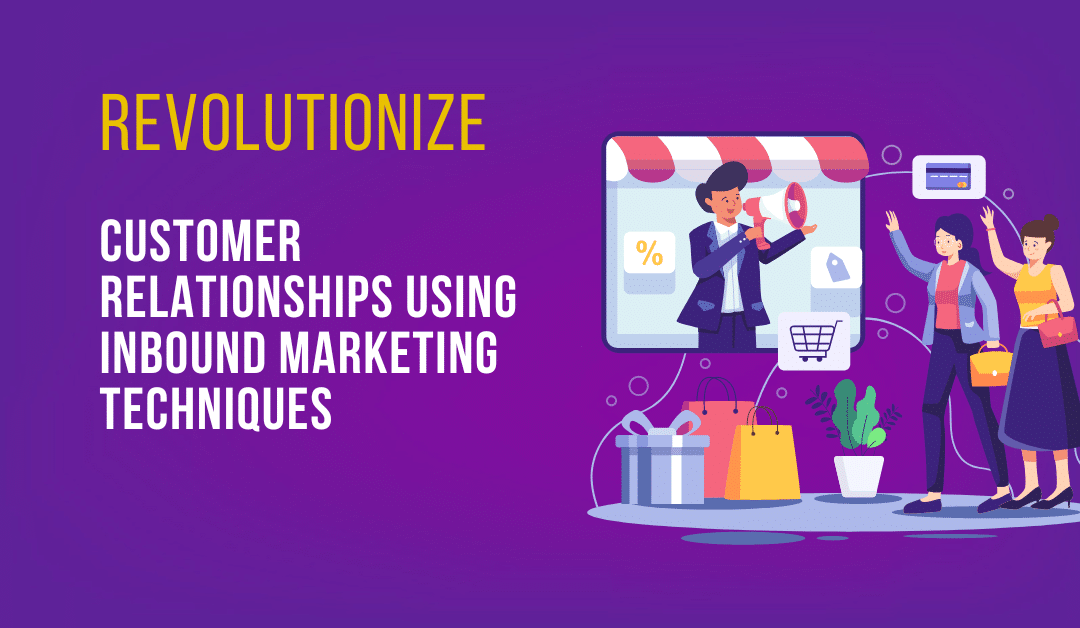Revolutionize Customer Relationships Using Inbound Marketing Techniques
Introduction
In today’s highly digital and competitive business landscape, establishing and maintaining strong customer relationships can be a daunting task. The rise of the internet and social media has drastically changed the way we communicate and interact with brands, making traditional marketing methods less effective. This is where inbound marketing techniques come in.
Inbound marketing, a customer-centric approach, focuses on creating valuable experiences that have a positive impact on people and your business. It’s about attracting prospects to your company through relevant and helpful content, adding value at every stage of your customer’s buying journey. But how can you leverage this strategy to revolutionize your customer relationships?
This article will delve into the role of inbound marketing in building trust, enhancing customer engagement, and nurturing long-term customer relationships. It will also explore key inbound marketing techniques and practical examples of successful strategies. Whether you’re a startup looking to grow your customer base or an established business aiming to improve customer retention, this comprehensive guide will provide you with the necessary insights. So, let’s dive in and revolutionize your customer relationships using inbound marketing techniques.

Understanding Inbound Marketing
What is Inbound Marketing?
Imagine marketing that doesn’t interrupt, but rather attracts customers by offering valuable content and experiences tailored specifically to them. That’s the magic of inbound marketing! Instead of pushing out generic content and hoping it sticks, inbound marketing takes a customer-centric approach. It seeks to build connections that customers are looking for and offers solutions to problems they already have.
The Purpose and Importance of Inbound Marketing
Inbound marketing has a clear purpose: to attract potential customers to your brand organically and nurture them into loyal customers over time. This is achieved by understanding customer needs, desires, and pain points, and delivering valuable content that addresses those areas. By doing so, you’re not only attracting traffic, but you’re also building trust and fostering long-term relationships.
The importance of inbound marketing lies in its ability to generate quality leads and convert them into customers. It’s a strategic, long-term approach that helps you understand and meet the needs of your customers, thus improving retention and brand loyalty.
Inbound Marketing vs Outbound Marketing
Inbound and outbound marketing are two sides of the same coin, but they have distinct approaches and results. Outbound marketing is all about reaching out to potential customers through tactics such as social media campaigns, door-to-door sales, or cold calls. It’s proactive but may feel intrusive to some people.
On the other hand, inbound marketing focuses on drawing customers to your brand organically. It involves creating valuable content that resonates with your target audience, making them want to engage with your brand. The goal is to build brand awareness and foster long-term relationships. It’s a more subtle, customer-centric approach that may require less time and save money spent on marketing costs.
Inbound Marketing vs Content Marketing
Inbound marketing and content marketing often get lumped together, but they’re not quite the same. Content marketing is a specific strategy focused on creating helpful content with the user’s interest in mind. This could include blog posts, articles, Q&As, and more.
Inbound marketing, however, encompasses a broader range of techniques, which include content marketing, but also extend to other strategies such as SEO, social media marketing, and email marketing. For instance, writing a blog post about the best strategies for social media marketing would be considered content marketing. But if that post also includes effective calls to action (CTAs), smart pop-ups, and an incentivized newsletter sign-up form, these additional techniques fall under the umbrella of inbound marketing.
Understanding these distinctions is key to developing a comprehensive marketing strategy that effectively engages and retains customers.

The Role of Inbound Marketing in Customer Relationships
In the digital age, the power dynamic has shifted, with consumers now at the helm. Customers have the ability to research, compare, and decide on the best product or service for their needs, all within a few clicks. As such, businesses must shift their marketing strategies to align with this new consumer behavior. Enter inbound marketing, a technique designed to draw customers in, rather than push a product or service on them. Inbound marketing plays a pivotal role in customer relationships, from building trust and enhancing engagement to nurturing long-term relationships.
Building Trust with Inbound Marketing
Trust is the cornerstone of any successful business relationship. But how can businesses foster trust in an online environment where face-to-face interactions are few and far between? Inbound marketing offers a solution.
Inbound marketing uses quality, persona-driven content to attract potential customers. This content is tailored to the needs and interests of the customer, addressing their unique challenges and offering solutions. This not only attracts the right customers but also positions your business as a trusted advisor in their journey.
In fact, statistics show that inbound marketing builds trust and relationships 27% faster compared to pushy sales tactics. When customers trust your brand, they’re more likely to engage with your content, share it with others, and ultimately, make a purchase.
Enhancing Customer Engagement through Inbound Marketing
Inbound marketing is not just about attracting customers; it’s also about engaging them. Engaging with customers involves creating valuable interactions at every stage of the buyer’s journey. This can be done through personalized email campaigns, social media interactions, webinars, or even live chats on your website.
Inbound marketing techniques go beyond just selling a product or service; they also provide value to the customer. This can be through useful guides, how-to videos, or informative blog posts. By offering value, you not only keep customers engaged but also encourage them to stay longer on your website, increasing the chances of a conversion.
Nurturing Long-Term Customer Relationships with Inbound Marketing
Inbound marketing is not a one-time strategy. It’s a continuous process of attracting, engaging, and delighting customers. This means even after a sale is made, the relationship doesn’t end. Delighting customers involves providing support, assistance, and added value even after a purchase.
This could take the form of post-purchase follow-ups, customer service support, or even loyalty programs. This not only increases customer satisfaction but also encourages repeat business. A satisfied customer is not only likely to become a repeat customer but also a brand advocate, promoting your business to others.
Inbound marketing is a long-term strategy, with research showing that it costs 18% less than traditional outbound marketing techniques. By focusing on building trust, enhancing engagement, and nurturing relationships, businesses can cultivate a community of loyal customers, ultimately driving growth and success in the long run.

Key Inbound Marketing Techniques for Customer Relationships
Inbound marketing is a strategic approach that uses various techniques to attract, engage, and delight customers. By using these techniques, businesses can build strong relationships that result in long-term customer loyalty. Here are some key techniques that can revolutionize customer relationships.
Creating and Sharing Compelling Content
Creating and sharing content that provides value to your audience is at the heart of inbound marketing. This might include blog articles, how-to guides, customer testimonials, promotional details, and more. This content should be optimized with an effective SEO strategy, targeting specific keywords and phrases related to your business, the problems you solve, and the ways you help your target audience. By doing so, your content will organically appear in search engine results for those who are looking for this information.
Utilizing Social Media for Customer Engagement
Social media platforms like Facebook, Twitter, LinkedIn, Instagram, and YouTube offer an excellent opportunity for businesses to engage with their audience. By sharing informative and engaging content, responding to comments and questions, and providing customer support, businesses can build strong relationships with their audience. Remember, every interaction, big or small, matters when it comes to customer engagement.
Implementing Effective Email Campaigns
Email campaigns are a powerful tool for maintaining and strengthening customer relationships. They allow businesses to communicate directly with customers, providing them with valuable information, updates, and offers. The key to an effective email campaign is personalization; each email should be tailored to the recipient’s interests and needs, ensuring that they see value in every communication.
Leveraging Influencer Marketing
Influencer marketing is a powerful inbound marketing technique, especially on platforms like Instagram and YouTube. By partnering with influencers who have a strong connection with your target audience, businesses can reach a wider audience and build trust through third-party endorsement.
Optimizing Website Experience for Mobile Users
More than half of all internet traffic comes from mobile devices, making mobile optimization a must for any business. A mobile-friendly website not only improves user experience but also contributes to better search engine rankings, helping attract more visitors to your site.
Using SEO to Attract and Retain Customers
Search engine optimization (SEO) is an essential part of any inbound marketing strategy. By optimizing your website and content for search engines, you can attract more visitors to your site and increase the visibility of your business online. Remember, SEO is not just about attracting visitors, but also about retaining them. A well-optimized website provides a better user experience, making visitors more likely to stay and interact with your content.
By implementing these key inbound marketing techniques, businesses can develop strong customer relationships that result in long-term loyalty and growth. Each technique plays a crucial role in attracting, engaging, and delighting customers, ultimately contributing to a successful inbound marketing strategy.

Practical Examples of Successful Inbound Marketing Strategies
The proof of the pudding is in the eating, they say. Let’s look at real-life examples of businesses that have successfully harnessed the power of inbound marketing techniques to revolutionize their customer relationships.
Chewy: Personalized Email Campaigns
Chewy, a popular online pet food and product retailer, is a prime example of a business that has mastered the art of personalized email campaigns. Instead of sending the same message to all their customers, Chewy uses customer data to create highly personalized emails. These emails are tailored to the specific needs of each customer, based on their previous purchases, browsing history, and pet preferences.
This approach has not only increased Chewy’s email engagement rates but also strengthened their customer relationships. Customers appreciate the personalized touch and feel valued, which in turn boosts customer loyalty and increases repeat purchases.
Indy: Influencer Marketing
Indy, a freelance platform, offers a great example of how to leverage influencer marketing to expand reach and engagement. Recognizing the power of influencers in today’s digital age, Indy collaborates with popular industry influencers to recommend their platform.
These influencers have a strong following of freelancers who trust their opinions and recommendations. By associating with these influencers, Indy taps into their audience and gains their trust. This strategy has helped Indy reach a wider audience, boost brand awareness, and drive more sign-ups for their platform.
These examples show how effective inbound marketing techniques can be in building strong customer relationships. Personalized email campaigns and influencer marketing are just two of the many techniques that businesses can use to attract, engage, and delight customers. The key is to understand your audience, provide value, and build a relationship based on trust and mutual benefit.

Tools for Implementing Inbound Marketing Techniques
To effectively implement the inbound marketing techniques that foster strong customer relationships, you need the right tools in your arsenal. Here are three essential tools that can help streamline your efforts and improve your inbound marketing strategy.
Jotform for Customer Surveys
No matter how well you think you know your audience, there’s always room for improvement. This is where Jotform comes in. It’s a free form builder with attractive templates and a host of desirable features. It not only helps you design engaging forms for newsletter sign-ups and service subscriptions but also facilitates creating customer surveys. These surveys can help you gain deeper insights into your audience’s needs and preferences, enabling you to tailor your inbound marketing strategies more effectively.
Mailchimp for Email Marketing
While Jotform helps you secure sign-ups, Mailchimp takes care of your email marketing and distribution needs. It offers both free and paid features, allowing you to customize your emails’ appearance, content, and delivery time. Mailchimp also enables you to create personalized email campaigns tailored to each subscriber segment, making it a powerful tool for lead generation and nurturing.
Buffer for Social Media Management
Finally, let’s not forget the pivotal role of social media in inbound marketing. Buffer is a tool that can significantly enhance your social media marketing plan. It allows you to schedule social media posts, ensuring your content is published when your target audience is most active. By automating most of the social media management tasks, Buffer saves you time and resources. This can be particularly beneficial for startups operating on a tight budget.
In conclusion, while these tools can simplify and amplify your inbound marketing efforts, it’s essential to remember that they are just tools. Their effectiveness lies in your ability to use them strategically and creatively, keeping your audience’s needs and preferences at the forefront.
Conclusion
The Future of Customer Relationships with Inbound Marketing Techniques
As we head into the future, the importance of personalizing customer experiences will only grow. In a digital world where attention is a precious commodity, businesses that can establish a personal connection with their audience will be at a competitive advantage. Inbound marketing, with its focus on creating quality content, fostering engagement, and building trust, is perfectly suited to this task.
Advancements in technology, such as AI and automation, will further refine inbound techniques, making it possible to personalize content and interactions at an unprecedented scale. For instance, AI can help in understanding customer behavior better and providing them with tailored recommendations, while automation can ensure that no potential lead falls through the cracks.
Final Thoughts on Inbound Marketing Techniques for Customer Relationships
Inbound marketing isn’t about hard sell. It’s about creating valuable relationships with your audience by providing them with content and experiences that resonate with their needs and values. It’s about turning strangers into customers and customers into advocates for your brand.
The evolution of the digital landscape has made it possible for customers to share their experiences with a brand at the push of a button, making every stage of the buyer’s journey crucial. Therefore, it’s essential to keep the customer at the center of your inbound strategy, aligning your marketing, sales, and customer service teams towards a common goal: customer delight.
The inbound methodology is not just a marketing strategy, but a philosophy that places the customer at the heart of all business activities. When implemented correctly, it can revolutionize customer relationships, turning one-time buyers into loyal fans and brand advocates.
Remember, inbound marketing is not a one-size-fits-all approach. It requires constant testing, learning, and adapting. However, with commitment, creativity, and a deep understanding of your audience, it can deliver significant returns for your business. The future belongs to those businesses that can authentically engage their audience, providing value at every touchpoint. So, are you ready to revolutionize your customer relationships with inbound marketing?

